Ghana. Adowa, the Unique Dance Style of the Ashanti.
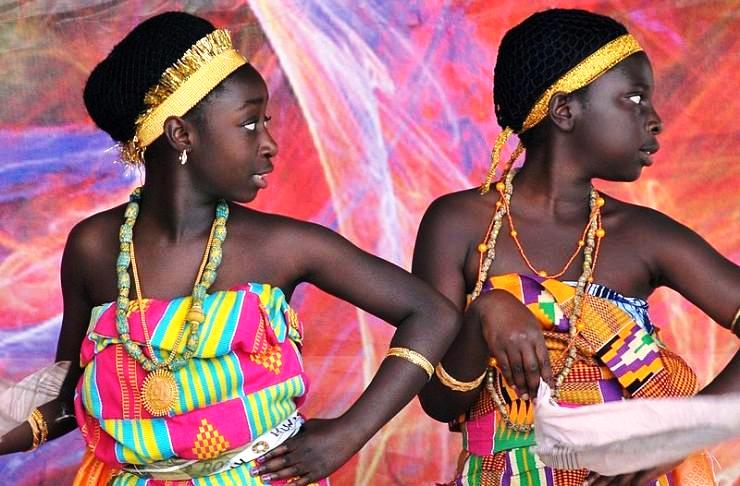
It is one of the most popular and unique dance styles practiced in Ghana. It belongs to an ethnic group called ‘Ashanti’, which is a part of the Akan community group.
The Adowa dance relates to the word Sankofa. Sankofa (sahn-KO-fah [san: ‘to return’] plus [ko: ‘to go’] plus [fa: ‘to look, to seek and take’]) is a word in the Twi language of the Akan community that translates as ‘Go back and get it’. Sankofa acknowledges that one’s understanding of their future is bound to them through culture and history. This concept is an affirmation of one’s past as being in constant practice and ever-present.
The dance exhibits the theories and conceits of black feminism in the Akan community. It is a traditional African dance said to have originated from the movement of an antelope (Adowa in Twi language).Oral history has it that the dance originated in the early days of warfare when, once, the Great Queen of the Ashantis (Abrewa Tutuwaa) was sick and the only way to get her healed was by obtaining a live antelope from the wild to pacify the gods and make her well again, as revealed by the chief priest.
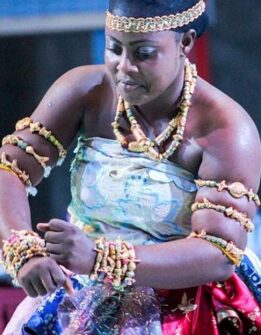
Adowa Dancer. CC BY-SA 4.0/ Fquasie
The delegation assigned to get this antelope witnessed the outstanding and captivating movements of the creature so, upon their arrival they imitated it and danced for all the households, demonstrating how the antelope exhibited such skillful moves. The old women also imitated and improvised the moves; hence it became a famous and much adored dance within the ethnic group, and it has been practiced until this date. Then it was done only by women, but men also do it now.
According to oral account, the Asafo warriors’ group was the first to have started the Adowa dance. Then old women also imitated and improvised the moves of the dance until it became an adored dance amongst the Ashanti ethnic group. A dance that was initially dominated by women now has no boundaries of gender.
The Adowa is commonly performed during festivals, funerals, marriages, and other celebrations. It has subtly become the official traditional dance to welcome dignitaries and popular personalities to Ghana.
The Adowa dance is a sign of expression that allows performers to communicate their emotions and feelings through their hands and feet. There are different hand movements performed for each setting; people will communicate positive emotions at weddings or engagements and negative emotions at funerals.
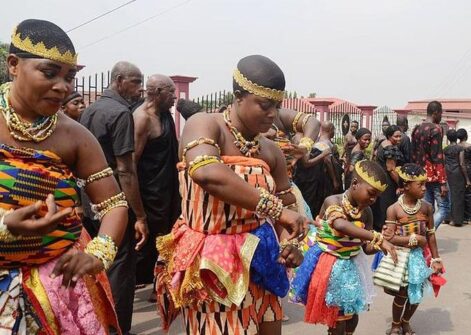
Women and little girls dancing Adowa. CC BY-SA 4.0/ Selina-Emma Laryea
This particular dance has a special attachment to royalty since every move, stance, or gesture is a message with meaning; hence, highly trained people usually do this dance in gatherings where Royals are present. The costume worn by the dancers while performing Adowa includes a piece of cloth wrapped around the body from the chest right down to the knees. In the case of women, a red or black cloth
is tied around the head.
Also, jewelry is mainly worn around the head, shoulders, upper arms, wrists, knees, and ankles. In addition, performers also carry a handkerchief, either coloured or dark depending on the occasion. For example, a dark-coloured handkerchief is generally carried only during funerals.Although any gender or age can do this dance, it is more adorable when little boys and girls perform it. The dancers usually adorn themselves in Kente (woven patterned cloth commonly made by the inhabitants of Bonwire, a town in the Ashanti region). The occasion determines the type of Kente to be worn; funerals are usually black and white since it is a moment of mourning and grief. The cloth usually covers the breast area to the knee.
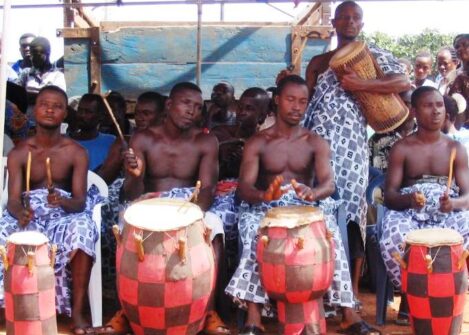
An Adowa ensemble comprises a lead singer, a chorus, and percussion instruments. Photo: Mirko Delazzari
All other functions use colourful Kente cloth which shows royalty, wealth, and status. The dancers decorate themselves with beads and golden necklaces. The beads are put on the wrist, ankles, knees, and neck. The ladies who have long hair cover them with black nets neatly wrapped over their hair. They also put golden bands around their heads to make them stand out. Those without long hair go by the Dansinkran style. This is when the dancers neatly dress their hair with black hair dye, which usually makes them beautiful and presentable.
An Adowa ensemble comprises a lead singer, a chorus, and percussion instruments. The instruments used in a classical Adowa performance are: atumpan (pair of ‘talking’ drums); petia, which is a tenor drum; apentemma, a supporting drum; dondo (hourglass drum); adawuraa (bell); trowa (made of gourd rattles); and rhythmic handclapping. There are normally two dondo (hourglass drums) and one or two adawuraa in the ensemble. The leader and the chorus are nearly always middle-aged women who accompany themselves with handclapping and/or with adawuraa (double bell) or an atoke (single bell).
The bell plays a steady rhythm, to which the chorus sings the responses. The lyrics of the songs express social and moral values such as, chiefs who have passed away, the grieving family, sympathy for the deceased, and the Akan faith.
In Adowa dance, women claim their own narratives and agency in each step and chant, as well as the attire they choose to wear. Adowa dancers are able to name themselves, and practice sisterhood and national pride.
The dancers use a symbolic language, with the different movements of their hands telling their own story. This body language is accentuated by the use of a white linen cloth, which they hold in their hand. The short dance steps are very subtle, drawing attention to the upper part of the body. The music is characterised by polyrhythmic accents, what the music accompanying Adowa is composed of.
In performing Adowa, the hands and feet are mainly utilized by the dancer. There are basic steps to this unique dance style. Firstly, the performer needs to apply pressure and move his or her right foot forward. Movements made by the dancer are exaggerated, and not exactly simple. During the performance, the dancer ensures that there is an interaction with the drummer that is not obvious. In addition, a sad facial expression generally needs to be exhibited by the dancer.
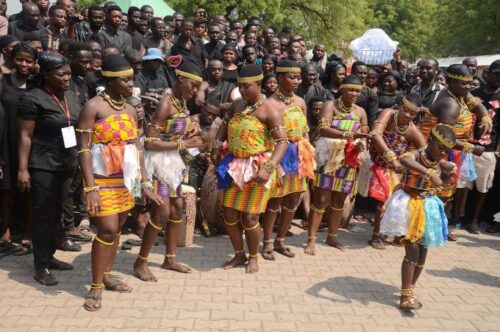
Adowa dance at the funeral of Asantehemaa. CC BY-SA 4.0/ Selina-Emma Laryea
The Adowa dance was originally performed by the Ashanti during funerals and festivals but due to modernity and cross-cultural adaptation, it can be performed by all ethnic groups in Ghana and even outside Ghana. In recent times, it is performed not only at festivities and funerals, but also at all kinds of social occasions, state gatherings, and various religious activities.
In fact, just as Ashanti’s funerals do not totally involve an expression of sadness, there are various Adowa movements to express joy, love, peace, and so on. The movement to express joy involves throwing up the arms and clasping the hands in jubilation. Love and peace are expressed by crossing both hands and fingers in a clasped position. For example, at the loftiness of a dance, if the dancer suddenly falls with his or her back into the arms or lap of another community member, particularly a prominent State official, he or she wishes to convey that he or she depends on the person.
Again, the theme of unity is always present in Adowa dance and is conveyed by crossing the arms and hands with palms opened, or by placing the two palms against one another vertically, as if the dancer has his or her hands clasped in prayer.
On the whole, Adowa movements and gestures affirm critical values and beliefs of the Akan community. In this way, with each successive performance, the role of the Akan traditional dance as a vehicle for expressing Akan’s ethnic identity, is not only ensured, but is enlivened with both individual spirit and the collective enthusiasm of the people of Asante. (Open Photo: Two young girls dancing Adowa. CC BY 2.0/Brendan)
Damian Dieu Donne Avevor



